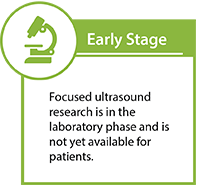Focused Ultrasound Therapy
Focused ultrasound is a noninvasive, therapeutic technology with the potential to improve the quality of life and decrease the cost of care for patients with muscle atrophy. This novel technology focuses beams of ultrasound energy precisely and accurately on targets deep in the body.
How it Works
Where the beams converge, pulsed focused ultrasound generates non-thermal stimulation of angiogenesis on satellite cells. In the preclinical research setting of decreased muscle use, this treatment yielded diminished muscle atrophy compared to controls. While this result is encouraging, more work is needed before this technique can move toward clinical application.
Advantages
The primary options for treatment of muscle atrophy are dependent on the perceived cause and can include invasive surgery.
For certain patients, focused ultrasound could provide a noninvasive alternative to surgery with less risk of complications – such as surgical wound healing or infection – at a lower cost. It can reach the desired target without damaging surrounding tissue and is repeatable, if necessary.
Clinical Trials
At the present time, there are no clinical trials recruiting patients for focused ultrasound treatment of muscle atrophy.
Regulatory Approval and Reimbursement
Focused ultrasound treatment for muscle atrophy is not yet approved by regulatory bodies or covered by medical insurance companies.
Notable Papers
Matsumoto Y, Nakano J, Oga S, Kataoka H, Honda Y, Sakamoto J, Okita M. The non-thermal effects of pulsed ultrasound irradiation on the development of disuse muscle atrophy in rat gastrocnemius muscle. Ultrasound Med Biol. 2014
Okita M, Nakano J, Kataoka H, Sakamoto J, Origuchi T, Yoshimura T. Effects of therapeutic ultrasound on joint mobility and collagen fibril arrangement in the endomysium of immobilized rat soleus muscle. Ultrasound Med Biol. 2009 Feb;35(2):237-44.
W. J. Tyler, Y. Tufail, M. Finsterwald, M. L. Tauchmann, E. J. Olson, and C. Majestic, “Remote excitation of neuronal circuits using low-intensity, low-frequency ultrasound.,” PLoS ONE, vol. 3, no. 10, Oct. 2008.
Click here for additional references from PubMed.

